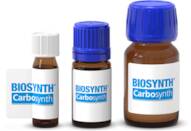
Produktinformation
- RTX
- (+)-Resiniferatoxin
- Benzeneacetic acid, 4-hydroxy-3-methoxy-, [(2S,3aR,3bS,6aR,9aR,9bR,10R,11aR)-3a,3b,6,6a,9a,10,11,11a-octahydro-6a-hydroxy-8,10-dimethyl-11a-(1-methylethenyl)-7-oxo-2-(phenylmethyl)-7H-2,9b-epoxyazuleno[5,4-e]-1,3-benzodioxol-5-yl]methyl ester
- Benzeneacetic acid, 4-hydroxy-3-methoxy-, [3a,3b,6,6a,9a,10,11,11a-octahydro-6a-hydroxy-8,10-dimethyl-11a-(1-methylethenyl)-7-oxo-2-(phenylmethyl)-7H-2,9b-epoxyazuleno[5,4-e]-1,3-benzodioxol-5-yl]methyl ester, [2S-(2α,3aβ,3bβ,6aβ,9aα,9bα,10α,11aβ)]-
- Daphnetoxin, 6,7-deepoxy-6,7-didehydro-5-deoxy-21-dephenyl-21-(phenylmethyl)-, 20-(4-hydroxy-3-methoxybenzeneacetate)
- Rtx-107
- [(2R,3aR,3bS,6aR,9aR,9bR,10R,11aR)-2-benzyl-6a-hydroxy-8,10-dimethyl-11a-(1-methylethenyl)-7-oxo-3a,6,6a,7,9a,10,11,11a-octahydro-3bH-2,9b-epoxyazuleno[4',5':5,6]benzo[1,2-d][1,3]dioxol-5-yl]methyl (4-hydroxy-3-methoxyphenyl)acetate
- [(2S,3aR,3bS,6aR,9aR,9bR,10R,11aR)-2-benzyl-6a-hydroxy-8,10-dimethyl-11a-(prop-1-en-2-yl)-7-oxo-3a,6,6a,7,9a,10,11,11a-octahydro-3bH-2,9b-epoxyazuleno[5,4-e]-1,3-benzodioxol-5-yl]methyl 2-(4-hydroxy-3-methoxyphenyl)acetate
- [(3aR,3bS,6aR,9aR,9bR,10R,11aR)-2-benzyl-6a-hydroxy-8,10-dimethyl-7-oxo-11a-(prop-1-en-2-yl)-3a,6,6a,7,9a,10,11,11a-octahydro-3bH-2,9b-epoxyazuleno[4',5':5,6]benzo[1,2-d][1,3]dioxol-5-yl]methyl (4-hydroxy-2-methoxyphenyl)acetate
- [(3aR,3bS,6aR,9aR,9bR,10R,11aR)-2-benzyl-6a-hydroxy-8,10-dimethyl-7-oxo-11a-(prop-1-en-2-yl)-3a,6,6a,7,9a,10,11,11a-octahydro-3bH-2,9b-epoxyazuleno[4',5':5,6]benzo[1,2-d][1,3]dioxol-5-yl]methyl (4-hydroxy-3-methoxyphenyl)acetate
- Mehr Synonyme anzeigen
Resiniferatoxin is found in the resin of the South American plant Euphorbia resinifera. It is known for its cytotoxic activity, which is due to its ability to inhibit protein synthesis by binding to the cytosolic Ca2+-dependent RNA polymerase. Resiniferatoxin has been shown to be effective in treating bowel disease and may also have a role in other diseases such as bone cancer and neurodegenerative disorders. Resiniferatoxin acts on the integrin receptor, which is localized on cells of specific tissues. The function of this receptor is not yet well understood, but it could have a pathogenic mechanism that leads to infectious diseases or cancer.
Chemische Eigenschaften
Technische Anfrage zu: 3D-FR45558 Resiniferatoxin
Wenn Sie ein Angebot anfordern oder eine Bestellung aufgeben möchten, legen Sie stattdessen die gewünschten Produkte in Ihren Warenkorb und fordern Sie dann ein Angebot oder eine Bestellung an aus dem Warenkorb. Es ist schneller, billiger und Sie können von den verfügbaren Rabatten und anderen Vorteilen profitieren.





